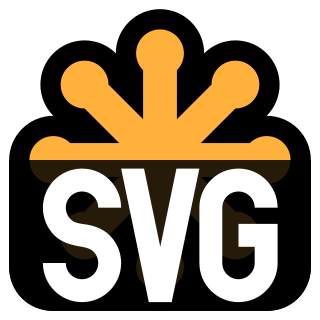Related Research Articles

Scalable Vector Graphics (SVG) is an XML-based vector image format for defining two-dimensional graphics, having support for interactivity and animation. The SVG specification is an open standard developed by the World Wide Web Consortium (W3C) since 1999.
Gecko is a browser engine developed by Mozilla. It is used in the Firefox browser, the Thunderbird email client, and many other projects.
Mathematical Markup Language (MathML) is a mathematical markup language, an application of XML for describing mathematical notations and capturing both its structure and content. It aims at integrating mathematical formulae into World Wide Web pages and other documents. It is part of HTML5 and is a ISO/IEC standard ISO/IEC 40314 since 2015.

Wireless Markup Language (WML), based on XML, is a now-obsolete markup language intended for devices that implement the Wireless Application Protocol (WAP) specification, such as mobile phones. It provides navigational support, data input, hyperlinks, text and image presentation, and forms, much like HTML. It preceded the use of other markup languages now used with WAP, such as HTML itself, and XHTML.
A favicon, also known as a shortcut icon, website icon, tab icon, URL icon, or bookmark icon, is a file containing one or more small icons, associated with a particular website or web page. A web designer can create such an icon and upload it to a website by several means, and graphical web browsers will then make use of it. Browsers that provide favicon support typically display a page's favicon in the browser's address bar and next to the page's name in a list of bookmarks. Browsers that support a tabbed document interface typically show a page's favicon next to the page's title on the tab, and site-specific browsers use the favicon as a desktop icon.
XForms is an XML format used for collecting inputs from web forms. XForms was designed to be the next generation of HTML / XHTML forms, but is generic enough that it can also be used in a standalone manner or with presentation languages other than XHTML to describe a user interface and a set of common data manipulation tasks.
OpenSearch is a collection of technologies that allow the publishing of search results in a format suitable for syndication and aggregation. Introduced in 2005, it is a way for websites and search engines to publish search results in a standard and accessible format.
In computer hypertext, a URI fragment is a string of characters that refers to a resource that is subordinate to another, primary resource. The primary resource is identified by a Uniform Resource Identifier (URI), and the fragment identifier points to the subordinate resource.
This article compares HTML support by several browser engines.
The following tables compare Document Object Model (DOM) compatibility and support for a number of JavaScript engines used in web browsers.

The Mozilla Application Suite is a discontinued cross-platform integrated Internet suite. Its development was initiated by Netscape Communications Corporation, before their acquisition by AOL. It was based on the source code of Netscape Communicator. The development was spearheaded by the Mozilla Organization from 1998 to 2003, and by the Mozilla Foundation from 2003 to 2006.
In computing, quirks mode is a technique used by some web browsers for the sake of maintaining backward compatibility with web pages designed for old web browsers instead of strictly complying with W3C and IETF standards in standards mode.
The canvas element is part of HTML5 and allows for dynamic, scriptable rendering of 2D shapes and bitmap images. It is a low level, procedural model that updates a bitmap. HTML5 Canvas also helps in making 2D games.
In computer science and web development, XML Events is a W3C standard for handling events that occur in an XML document. These events are typically caused by users interacting with the web page using a device, such as a web browser on a personal computer or mobile phone.

HTML5 is a markup language used for structuring and presenting content on the World Wide Web. It is the fifth and final major HTML version that is a World Wide Web Consortium (W3C) recommendation. The current specification is known as the HTML Living Standard. It is maintained by the Web Hypertext Application Technology Working Group (WHATWG), a consortium of the major browser vendors.
Extensible HyperText Markup Language (XHTML) is part of the family of XML markup languages. It mirrors or extends versions of the widely used HyperText Markup Language (HTML), the language in which Web pages are formulated.

Google Chrome Frame was a plug-in designed for Internet Explorer based on the open-source Chromium project, first announced on September 22, 2009. It went stable in September 2010, on the first birthday of the project. It was discontinued on February 25, 2014 and is no longer supported.
This article compares web typography support for several browser engines.
References
Gecko references
- "the mozilla.org projects list". MathML in Mozilla. Retrieved May 1, 2005.
- "the mozilla.org projects list". Mozilla SVG project. Retrieved May 1, 2005.
- "the mozilla.org projects list". Mozilla XForms project. Retrieved May 1, 2005.
Opera references
- ↑ Feature History, Opera, archived from the original on 2012-09-06, retrieved 2011-12-30
- ↑ "Opera Features". RSS/Atom. Archived from the original on May 9, 2005.
- ↑ Feature History, Opera, archived from the original on 2012-09-06, retrieved 2011-12-30
- ↑ Feature History, Opera, archived from the original on 2012-09-06, retrieved 2011-12-30
- ↑ "Opera Features". RSS. Archived from the original on August 2, 2004.
- ↑ Feature History, Opera, archived from the original on 2012-09-06, retrieved 2011-12-30
- ↑ Feature History, Opera, archived from the original on 2012-09-06, retrieved 2011-12-30
- ↑ "Opera Features". SVG. Archived from the original on April 14, 2005. Retrieved May 1, 2005.
WebKit references
Other references
- "W3C". XHTML media type test. Retrieved May 1, 2005.
- "Developer's corner". Authoring XHTML+Voice. Retrieved May 1, 2005.